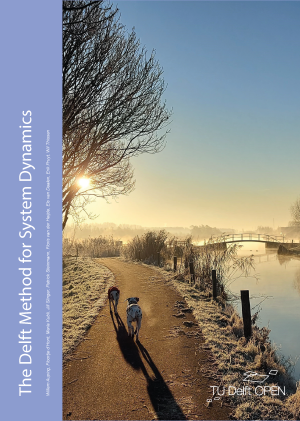The Delft Method for System Dynamics
Keywords:
system dynamics, education, simulation modellingSynopsis
The Delft Method for System Dynamics (SD) is a proven method for learning basic SD. The method focuses on learning by doing: first you try to work through an exercise, and if you do not understand something, then you can look up the theory. The book contains exercises on topics such as causal loop diagrams, delays, and when SD is an appropriate methodology. It also contains modelling exercises that show students how to build low to medium complexity models, and how to use these models for policy analysis. The theory chapters cover all phases of the modelling cycle: problem articulation, conceptualisation, formulation, evaluation (including validation and scenario analysis), and policy analysis. This book is intended for students and teachers in large or small System Dynamics courses, and for motivated students that want to learn SD at their own pace.
Downloads
References
Auping, W. L. (2018). Modelling Uncertainty: Developing and Using Simulation Models for Exploring the Consequences of Deep Uncertainty in Complex Problems.(PhD). Delft University of Technology, Delft
Auping, W. L., & d'Hont, F. M. (2023). A beginners' guide to debugging SD models. Paper presented at the International System Dynamics Conference, Chicago
Auping, W. L., d'Hont, F. M., Kubli, M. D., Steinmann, P., Slinger, J., Heijde, F. v. d., . . . Thissen, W. A. H. (2024). The Delft Method for System Dynamics -Modelling Exercises. SURFsharekit publication
Auping, W. L., Pruyt, E., De Jong, S., & Kwakkel, J. H. (2016). The geopolitical impact of the shale revolution: Exploring consequences on energy prices and rentier states. Energy Policy, 98(2016), 390-399 https://doi.org/10.1016/j.enpol.2016.08.032
Auping, W. L., Pruyt, E., & Kwakkel, J. H. (2017). Simulating endogenous dynamics of intervention-capacity deployment: Ebola outbreak in Liberia. International Journal of Systems Science: Operations & Logistics, 4(1), 53-67. https://doi.org/10.1080/23302674.2015.1128576
Balci, O. (1994). Validation, verification, and testing techniques throughout the life cycle of a simulation study. Annals of Operations Research, 53(1), 121-173 https://doi.org/10.1007/BF02136828
Balci, O. (2013). Verification, Validation, and Testing of Models. In S. I. Gass & M. C. Fu (Eds.), Encyclopedia of Operations Research and Management Science(pp. 1618-1627). Boston, MA: Springer US https://doi.org/10.1007/978-1-4419-1153-7_1108
Barlas, Y. (1996). Formal aspects of model validity and validation in system dynamics. System Dynamics Review, 12(3), 183-210. https://doi.org/10.1002/(SICI)1099-1727(199623)12:3<183::AID-SDR103>3.0.CO;2-4
Borelli, R. L., & Coleman, C. S. (2004). Differential Equations. A Modeling Perspective. New York: John Wiley & Sons, Inc
Bossel, H. (2007a). System Zoo 1 Simulation Models: Elementary Systems, Physics, Engineering. Norderstedt, Germany: Books on Demand GmbH
Bossel, H. (2007b). System Zoo 2 Simulation Models: Climate, Ecosystems, Resources. Norderstedt. Germany: Books on Demand GmbH
Bossel, H. (2007c). System Zoo 3 Simulation Models: Economy, Society, Development. Norderstedt, Germany: Books on Demand GmbH
Boyce, W. E., & DiPrima, R. C. (2005). Elementary Differential Equations and Boundary Value Problems(8th ed.). New York: John Wiley & Sons
Bryant, B. P., & Lempert, R. J. (2010). Thinking inside the box: A participatory, computer-assisted approach to scenario discovery. Technological Forecasting and Social Change, 77(1), 34-49 https://doi.org/10.1016/j.techfore.2009.08.002
Carver, R. (1996). Theory for Practice: A Framework for Thinking about Experiential Education. Journal of Experiential Education, 19(1), 8-13 https://doi.org/10.1177/105382599601900102
Coyle, R. G. (1996). System Dynamics Modelling. A practical approach. Dordrecht, Netherlands: Springer-Science+Business Media, B.Y https://doi.org/10.1007/978-1-4899-2935-8_5
De Jong, S., Auping, W. L., & Govers, J. (2014). The Geopolitics of Shale Gas. Retrieved from The Hague: http://static.hcss.nl/files/uploads/2180.pdf
Duggan, J. (2016). System Dynamics Modeling with R. Switzerland: Springer International Publishing.
Euler, L. (1768). Institutionum calculi integralis. Petropoli: Impensis Academiae Imperialis Scientiarum.
Fleming, N. D. (1995). I'm Different; Not Dumb. Modes of Presentation (VARK) in the Tertiary Classroom.Paper presented at the Research and Development in Higher Education.
Ford, A. (2009). Modeling the Environment(2nd ed.): Island Press.Forrester, J. W. (1961). Industrial Dynamics. Cambridge, MA: MIT Press.
Forrester, J. W. (1969). Urban Dynamics: Pegasus Communications.
Forrester, J. W. (1994). System dynamics, systems thinking, and soft OR. System Dynamics Review, 10(2-3), 246-256. https://doi.org/10.1002/sdr.4260100211
Forrester, J. W., & Senge, P. M. (1980). Tests for Building Confidence in System Dynamics Models. In A. A. Lagasto, J. W. Forrester, & J. M. Lyneis (Eds.), TIMS Studies in the Management Sciences(Vol. 14, pp. 209-228). Amsterdam, Netherlands: North-Holland Publishing Company.
Gardner, H. E. (1983). Frames of mind: The theory of multiple intelligences. New York, NY: Basic Books
Hanau, A. (1928). Die Prognose der Schweinepreise. Berlin: Verlag von Reimar Hobbing
Hodges, J. S., & Dewar, J. A. (1992). Is It You or Your Model Talking? A Framework for Model Validation. Retrieved from Santa Monica, CA: http://www.rand.org/content/dam/rand/pubs/reports/2006/R4114.pdf
Keating, E. H. (1998). Everything You Ever Wanted to Know about How to Develop A System Dynamics Model, But Were Afraid to Ask. Paper presented at the 16th International Conference of the System Dynamics Society, Quebec, Canada. http://www.systemdynamics.org/conferences/1998/PROCEED/00024.PDF
Krugman, P. (2012). End This Depression Now!New York, London: W.W. Norton & Company.
Kutta, M. W. (1901). Beitrag zur näherungsweisen Integration totaler Differentialgleichungen. Z. Math. Phys., 46, 435-453.
Kwakkel, J. H. (2017). The Exploratory Modeling Workbench: An open source toolkit for exploratory modeling, scenario discovery, and (multi-objective) robust decision making. Environmental Modelling and Software, 96, 239-250 https://doi.org/10.1016/j.envsoft.2017.06.054
Kwakkel, J. H., Auping, W. L., & Pruyt, E. (2013). Dynamic scenario discovery under deep uncertainty: The future of copper. Technological Forecasting & Social Change, 80(4), 789-800 https://doi.org/10.1016/j.techfore.2012.09.012
Kwakkel, J. H., Eker, S., & Pruyt, E. (2016). How robust is a robust policy? Comparing alternative robustness metrics for robust decision-making. In International Series in Operations Research and Management Science(Vol. 241, pp. 221-237): Springer https://doi.org/10.1007/978-3-319-33121-8_10
Lane, D. C. (1993). The road not taken: Observing a process of issue selection and model conceptualization. System Dynamics Review, 9(3), 239-264. https://doi.org/10.1002/sdr.4260090303
Lane, D. C. (1995). The Folding Star: A comperative reframing and extension of validity concepts in system dynamics. Paper presented at the Procedings of the 1995 International System Dynamics Conference, Tokyo, Japan
Lane, D. C. (2000). Diagramming conventions in system dynamics. Journal of the Operational Research Society, 51(2), 241-245 https://doi.org/10.1057/palgrave.jors.2600864
Lempert, R. J., Groves, D. G., Popper, S. W., & Bankes, S. C. (2006). A General, Analytic Method for Generating Robust Strategies and Narrative Scenarios. Management Science, 52(4), 514-528. https://doi.org/10.1287/mnsc.1050.0472
Martinez-Moyano, I. J. (2012). Documentation for model transparency. System Dynamics Review, 28(2), 199-208 https://doi.org/10.1002/sdr.1471
Mayer, J., Khairy, K., & Howard, J. (2010). Drawing an elephant with four complex parameters. American Journal of Physics, 78(6), 648-649 https://doi.org/10.1119/1.3254017
McKay, M. D., Beckman, R. J., & Conover, W. J. (1979). A Comparison of Three Methods for Selecting Values of Input Variables in the Analysis of Output from a Computer Code. Technometrics, 21(2), 239-245 https://doi.org/10.1080/00401706.1979.10489755
McPhail, C., Maier, H. R., Kwakkel, J. H., Giuliani, M., Castelletti, A., & Westra, S. (2018). Robustness Metrics: How Are They Calculated, When Should They Be Used and Why Do They Give Different Results? Earth's Future, 6(2), 169-191 https://doi.org/10.1002/2017EF000649
Meadows, D. H. (1976, 1976). The Unavoidable A Priori.Paper presented at the International Conference on System Dynamics
Meadows, D. H. (2008). Thinking in Systems. A Primer. London, UK: Earthscan
Meadows, D. H., Meadows, D. L., Randers, J., & Behrens, W. W., III. (1972). The Limits to Growth: A Report for the Club of Rome's Project on the Predicament of Mankind. New York: Universe Books https://doi.org/10.1349/ddlp.1
Morecroft, J. D. W. (1982). A Critical Review of Diagramming Tools for Conceptualizing Feedback System Models. Dynamica, 8(1), 20-29
Morecroft, J. D. W. (2015). Strategic Modelling and Business Dynamics: A feedback systems approach(2nd ed.): John Wiley & Sons https://doi.org/10.1002/9781119176831
Nordhaus, W. D. (1973). World Dynamics: Measurement Without Data. The Economic Journal, 83(332), 1156-1183 https://doi.org/10.2307/2230846
Oreskes, N., Shrader-Frechette, K., & Belitz, K. (1994). Verification, Validation, and Confirmation of Numerical Models in the Earth Sciences. Science Magazine, 263(5147), 641-646 https://doi.org/10.1126/science.263.5147.641
Pruyt, E. (2013). Small System Dynamics Models for Big Issues: Triple Jump towards Real-World Complexity
Randers, J. (Ed.) (1980). Elements of the System Dynamics Method. Cambridge, MA: Productivity Press
Richardson, G. P., & Pugh, A. L., III. (1981). Introduction to System Dynamics Modeling with Dynamo. Cambridge, MA: MIT Press
Roberts, E. B. (1978). Managerial Applications of System Dynamics. In E. B. Roberts (Ed.)
Runge, C. D. T. (1895). Über die numerische Auflösung von Differentialgleichungen. Math. Ann., 46, 167-178 https://doi.org/10.1007/BF01446807
Sciarone, A. G., & Montens, F. (1985). Nederlands Voor Buitenlanders. Toegepaste Taalwetenschap in Artikelen, 22, 156-165 https://doi.org/10.1075/ttwia.22.13sci
Senge, P. M. (1990). The Fifth Discipline: The Art and Practice of the Learning Organization. New York, NY: Doubleday/Currency
Sterman, J. D. (1994). Learning in and about complex systems. System Dynamics Review, 10(2-3), 291-330 https://doi.org/10.1002/sdr.4260100214
Sterman, J. D. (2000). Business Dynamics: Systems Thinking and Modeling for a Complex World. New York: McGraw.
Strang, G., & Herman, E. J. (2016). Calculus Volume 2. Houston, TX
Van Daalen, C. E., Thissen, W. A. H., & Phaff, H. W. G. (2006). spm2310/epa1321 Continuous Systems Modelling/System Dynamics. Delft: Technology, Policy and Management
Ventana Systems. (2010). Vensim Reference Manual. Harvard, MA: Ventana Systems
Warren, K. (2002). Competitive Strategy Dynamics: John Wiley & Sons
Wolstenholme, E. F. (1989a). Applying System Dynamics. Transactions of the Institute of Measurement and Control, 11(4), 170-179 https://doi.org/10.1177/014233128901100401
Wolstenholme, E. F. (1989b). System Enquiry: a System Dynamics Approach. Chichester: John Wiley & Sons





